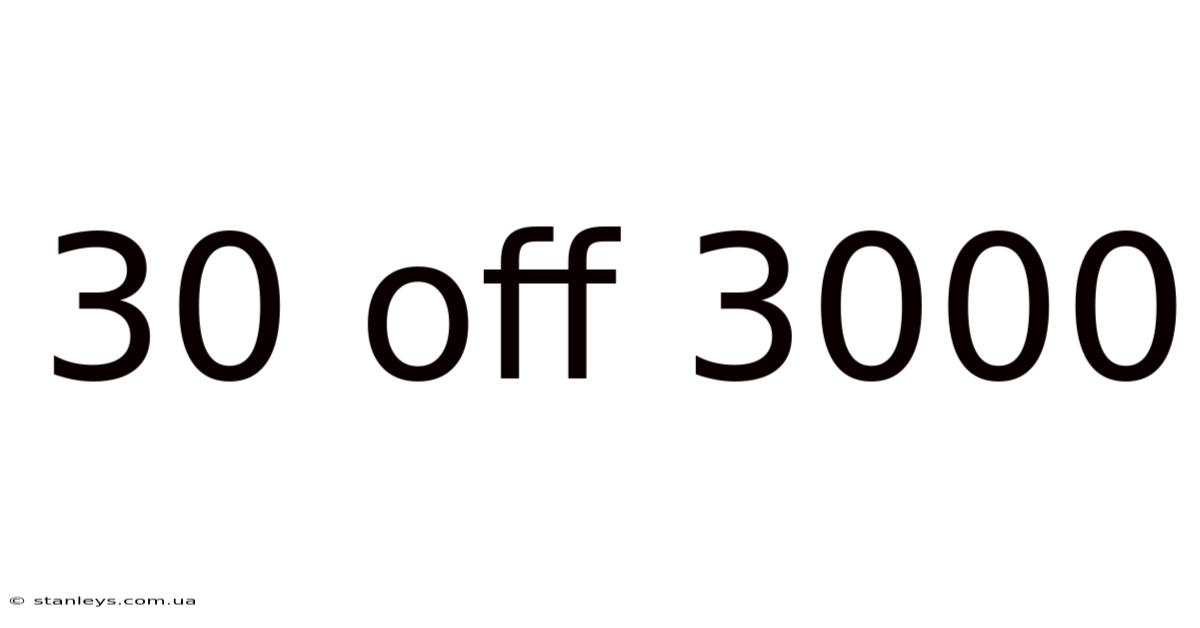30 Off 3000
stanleys
Sep 17, 2025 · 4 min read

Table of Contents
Decoding "30 Off 3000": A Comprehensive Guide to Discounts and Savings
Are you intrigued by a "30 off 3000" deal? This phrase, commonly seen in sales and promotions, represents a significant discount, but understanding exactly what it means and how to leverage it effectively requires a bit of unpacking. This comprehensive guide will explore the intricacies of this type of discount, explain its calculation, provide examples across different scenarios, and discuss strategies to maximize your savings. We'll also address common questions and misconceptions surrounding such promotional offers.
Understanding the "30 Off 3000" Discount
The phrase "30 off 3000" signifies a 30% discount on a purchase of $3000 or more. It's crucial to understand that this is a percentage-based discount, not a flat $30 deduction. The actual amount saved depends on the final price of the goods or services purchased, provided it meets the minimum spending threshold of $3000.
Calculating Your Savings: Step-by-Step Guide
Let's break down how to calculate the discount and your final price:
-
Determine the Original Price: This is the pre-discount price of the items in your shopping cart. Make sure it totals $3000 or more to qualify for the 30% discount.
-
Calculate the Discount Amount: Multiply the original price by the discount percentage (30%). For example, if your total is $3000, the discount calculation would be: $3000 x 0.30 = $900
-
Subtract the Discount: Deduct the discount amount from the original price to find the final price. Using our example: $3000 - $900 = $2100. This means you'll pay $2100 instead of $3000.
-
Consider Taxes: Remember that sales tax will usually be calculated on the final price after the discount has been applied, not the original price. Therefore, your total cost will be slightly higher than $2100, depending on your local tax rate.
Examples in Different Scenarios
Let's examine how this discount applies to various scenarios:
Scenario 1: Exact Threshold
- Original Price: $3000
- Discount (30%): $3000 x 0.30 = $900
- Final Price (before tax): $3000 - $900 = $2100
Scenario 2: Price Above Threshold
- Original Price: $4000
- Discount (30%): $4000 x 0.30 = $1200
- Final Price (before tax): $4000 - $1200 = $2800
Scenario 3: Combining Discounts
Sometimes, promotions might stack. For example, you might have a store credit or loyalty points that can be applied after the 30% discount. Let's say you have a $100 store credit:
- Original Price: $3500
- Discount (30%): $3500 x 0.30 = $1050
- Price after 30% discount: $3500 - $1050 = $2450
- Price after store credit: $2450 - $100 = $2350
Maximizing Your Savings with "30 Off 3000"
To make the most of "30 off 3000" deals, consider these strategies:
-
Strategic Shopping: Plan your purchases to reach the $3000 threshold. If you've been planning to buy multiple items anyway, consolidating your purchases can unlock significant savings.
-
Bundle Purchases: Many retailers offer bundled packages that might help you reach the minimum spending limit.
-
Check for Additional Offers: Look for additional discounts, coupons, or loyalty program benefits that can be combined with the 30% offer.
-
Read the Fine Print: Always carefully review the terms and conditions of the promotion to understand any exclusions or restrictions.
The Scientific Explanation Behind Percentage Discounts
Percentage discounts are a fundamental concept in mathematics and retail pricing. They are essentially a way to express a reduction in price as a proportion of the original price. The formula is straightforward:
Discount Amount = Original Price × (Discount Percentage / 100)
This formula is widely applied across various fields, not just retail, demonstrating its practical importance in everyday calculations. Understanding the underlying mathematical principle empowers consumers to make informed purchasing decisions.
Frequently Asked Questions (FAQ)
Q: What happens if my total is less than $3000?
A: You won't qualify for the 30% discount. You'll pay the full price of your items.
Q: Is tax included in the discount calculation?
A: No, tax is usually calculated on the final price after the discount is applied.
Q: Can I use this discount on sale items?
A: It depends on the specific terms and conditions of the promotion. Some promotions may exclude sale items. Always check the fine print.
Q: Can I combine this discount with other offers?
A: This depends on the retailer's policies. Some promotions allow stacking discounts, while others do not. Check the terms and conditions for details.
Q: What if I return an item after applying the discount?
A: The refund will usually be calculated based on the price you paid after the discount was applied.
Conclusion: Unlocking the Power of "30 Off 3000"
The "30 off 3000" deal presents a substantial opportunity to save money, particularly on larger purchases. By understanding the calculation, exploring various scenarios, and employing smart shopping strategies, you can maximize your savings. Remember to always carefully read the terms and conditions of any promotion before making a purchase to ensure you get the best possible deal. Armed with this knowledge, you can confidently navigate sales and promotions, turning seemingly complex discounts into tangible savings. Happy shopping!
Latest Posts
Latest Posts
-
Crunchy Roll Sushi
Sep 17, 2025
-
Precious Stone Crossword
Sep 17, 2025
-
Electrons In Magnesium
Sep 17, 2025
-
90 To Feet
Sep 17, 2025
-
200 Of 5
Sep 17, 2025
Related Post
Thank you for visiting our website which covers about 30 Off 3000 . We hope the information provided has been useful to you. Feel free to contact us if you have any questions or need further assistance. See you next time and don't miss to bookmark.